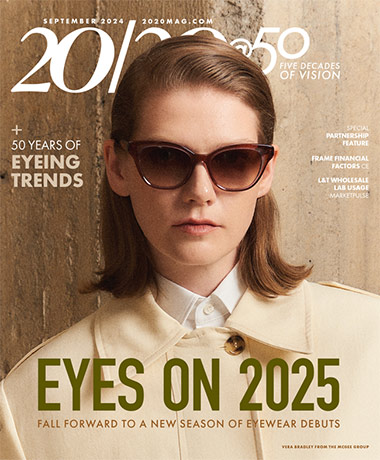How Survey Feedback From The Opticians Association of America Members Influenced Its Content
In a previous Opticians Handbook article, I gave a general overview of the evolution of the ANSI Z80.1 standard and how it has changed over time. In this article, I will discuss how an online survey that we conducted in cooperation with the Opticians Association of America helped the committee's decision-making process with the revision of the ANSI Standard in 2010.
The 2010 ANSI review committee was particularly interested in feedback on what was common practice when checking powers and tolerances when ECPs were inspecting lenses for acceptance.
The 2005 ANSI Standard included a requirement (adopted from ISO in 1995) that required power tolerances based upon the meridian with the strongest power. Using this method required a look up table to apply relevant tolerances depending upon the highest meridianal power value. It was suspected that many were not utilizing this method, but instead were testing using a simpler method. This simpler (but well established) method simply required use of the differences between prescribed and measured lens sphere and cylinder (difference) lens powers. If both errors were less than or equal to 0.12 then the lens would pass. I was a proponent of this "traditional" well understood method, which had been utilized prior to 1995 in the ANSI 80.1 Standard.
Before ANSI would consider reverting to older method, I was charged with determining if this "ISO" method was truly being used, or being ignored. As a means of obtaining this feedback, I drafted a list of questions to ask online, using the Internet "Zoomerang" questionnaire tool. The questionnaire was sent to the Optician Association of America members and their anonymous responses were tabulated. The feedback from 331 responses received was extremely useful to the committee, and had the following breakdown as to their affiliation:
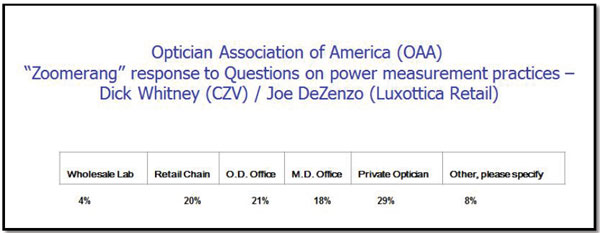
There were 10 questions asked of those participating, and these questions were designed to separate out actual practice from "claims." It was realized that it is fairly is common to state one follows the ANSI Standard but also likely that many were not aware of the ramification s of ANSI Z80.1 revisions over the past 10 years.
Feedback from OAA Questionnaire
The questions included inquiries about the type of Focimeter used, measurement practices, and an actual "test example" of a lens. This example was designed to fail if tolerancing lens power by "ISO Method," yet pass if using the proposed "common method."
The first question established what type of instrument they used. Not surprisingly, the manual focusing Focimeter was the most common device, with 65 percent responding that was their instrument of choice.
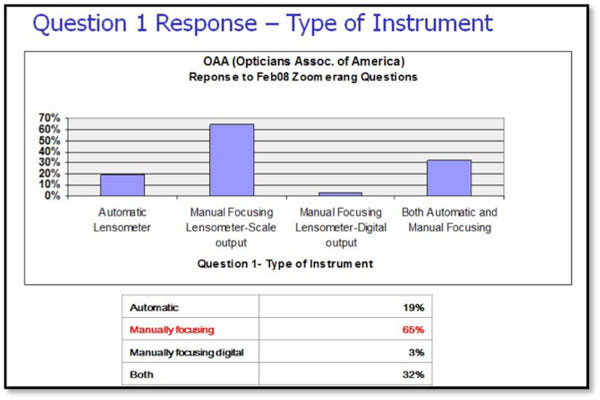
Subsequent questions asked participants what device settings were used where applicable. For those using electronic display devices, 82 percent responded they used the minus cyl display mode. Additionally, when asked what rounding display setting was utilized, 52 percent stated they either used a rounding of 0.12 or no rounding, while 23 percent set their device to 0.25D rounding.
The next few questions asked about the details of what specification(s) they used to obtain additional background for this topic. Question 7 delved into measurement practices. Study participants were asked "What action(s) might you take if the lens has been found to be out of tolerance for power?" The results were as follows:
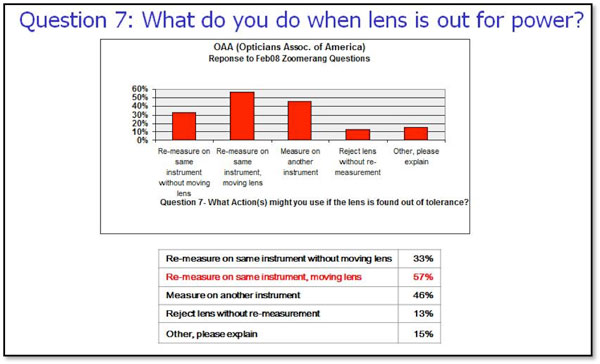
This response was illuminating and at the same time the feedback was not surprising. Since measurement uncertainty is important to consider when determining whether to reject for lens power. Nearly 60 percent indicated they move the lens and re-measure on the same device. Only 13 percent indicated that rejection occurred without re-measurement.
Question 8 asked if their device was hooked up to a computer. Since this is the only practical way to readily apply the "ISO" method of meridional power tolerancing, this was important. The replies indicated that 93 percent did not have such a capability.
The final question was the fundamental test, and asked if the measured lens power for sphere/cyl when compared to the specified Rx would be acceptable?
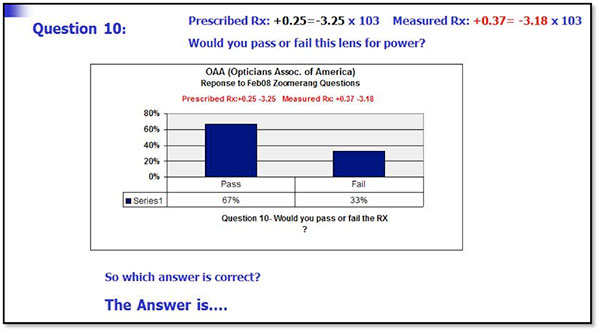
Since this example we designed to result in different answers depending upon the tolerance method used, the answer to which answer was correct was "...it depends."
If, as suspected, the older ANSI method was being used, the lens would pass. The slide below shows how this would result in a "pass" using this method.
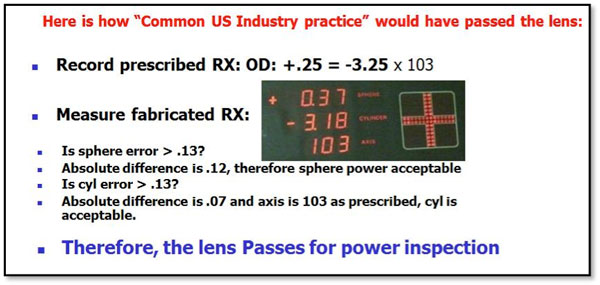
If, however, the "ISO" method used in ANSI Z80.1 from 1995 to 2005 were used, the lens would fail as shown below:
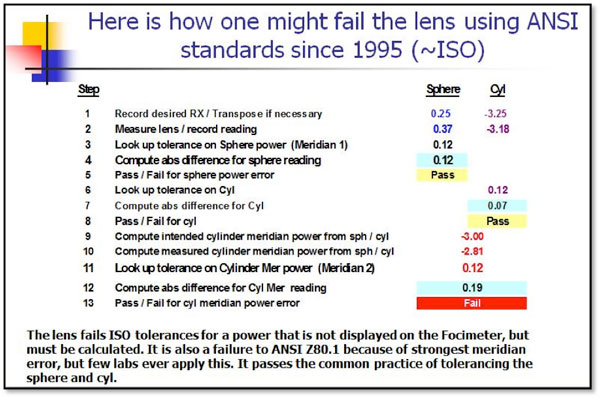
The final question was the proof that the ANSI Z80.1 committee was looking for to determine if the "ISO" method was being used. It was not.

The project of revising the ANSI Standards relied heavily on the input and participation of eyecare practitioners like you. This is a great example of how the involvement of ECPs had a powerful impact and contribution to the ANSI Z80.1standard.
For those who wish to see the entire presentation summarizing the study and its results, one can download a PowerPoint executable program from my website.
For further background on the history behind the ANSI/ISO Power tolerance methods and their usage in the standards, one may view another slideshow presentation here.





